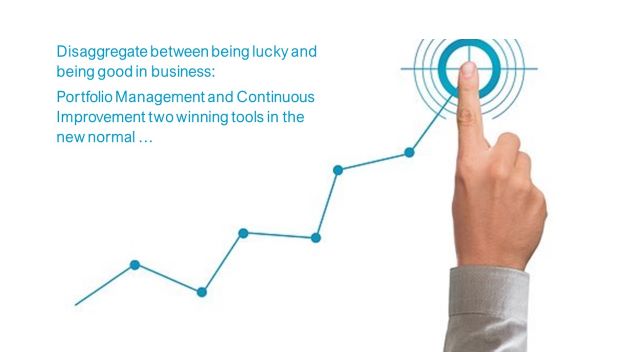An analysis of financial results of several hundreds of companies from 2008 to 2018 through a long cycle of downturn, recovery and growth indicate that, those businesses that put its portfolio on the move tend to outperform. The reverse is true as well. Businesses with a static portfolio serially underperform. Why? Because the market moves on and the company doesn’t.
In such a scenario, Portfolio Management and Continuous Improvement are two key time-tested tools to win the game. The worse your starting position, more urgent it becomes to shift to a faster track. |
Portfolio Management:
Here are seven main takeaways from my review of the aforementioned finance study-
1. Keep the portfolio moving:
There is an optimal rate to rotate the industry you operate in. Leading companies tend to rotate their portfolios steadily, not widely. Also, do not keep them fixed in a place.
2. Move with the market:
Headwinds and tailwinds matter a lot. Best companies identify where the winds are shifting and deploy resources aggressively where they predict the value creation to be. Work to create value. Anything that is not ‘value’ is ‘waste’; and wastes lead to high operational costs.
3. Manage innovations:
Organizations that wisely invested in innovation be it product or process innovations created profitable portfolios. Like all aspects of business, innovation too must be well-managed for it to be strategic, customer-centric and profitable. Innovation management becomes more critical in todays times where economy is battered, and organizations face heavy budget crunch. (Tip- Remember innovation is not R&D. I have a separate post explaining the difference).
4. Use M&A to speed up your way:
Mergers and acquisitions are generally essential to realize value creation. There are different approaches to M&A and they tend to produce different outcomes. I shall write a separate post on tips and tools for M&A during crisis/ challenging business environment. The central message though is that, high performers conduct programmatic M&A. The next logical question is- How far from your core should you aim M&A?
5. Focus on acquisitions at the perimeter of your portfolio:
The acquisition radius study is vital before each M&A deal and this acquisition radius is based on the type of acquisition. Broadly, there are four main categories of acquisitions-
- Adding to portfolio’s primary, including segment.
- Adding to an existing secondary industry segment.
- Buying into a segment adjacent to an existing business.
- Stepping out into an unrelated industry.
The odds are best when companies use M&A to accelerate a move towards new opportunities in existing but secondary businesses that is outside, but not too far outside of their core sectors.
6. Go harder when you are in a tough spot:
How you stack up against your competitors affects how hard you need to pull-on these levers. Make aggressive portfolio moves when you are fallen behind. When you have a declining business focusing on performance improvement alone and ignoring your portfolio does little for your odds of sharply turning things around.
7. Top performers are relentless capital reallocators:
They assign their current businesses to the categories 'grow’, ‘maintain’, ‘dispose’ and keep clearly differentiated rules for how much capital goes into each.
How to conduct portfolio management strategically to thrive in the new normal is a vast topic. I shall be writing several blog posts on this in the coming days, so do stay tuned-in. For now, let’s move on to the second winning tool- Continuous Improvement.
Continuous Improvement:
A dynamic portfolio demands strategic Continuous Improvement of products and business process alike. In most organizations, Continuous Improvement on product usually happens as a part of business development group's product life cycle management agenda via market research and financial models, though it is not the ideal way to do it.
To get best ROI, Continuous Improvement of products and services must be done via time-tested tools (that include market research as a baseline and grow further) such as Kaizen, Design Thinking, Scrum, Agile, TRIZ or Hoshin Kanrii. |
Continuous Improvement of business process(es) must be done strategically using proven Business Process Improvement techniques. |
Effective Portfolio Management and strategic Continuous Improvement have proved themselves in good times and bad, and they are also harder to apply than they seem on the face of it. But how much derives comes from taking steps to get there…
If you feel like the call to enrich your company's portfolio, manage innovations and implement strategic continuous improvement needs best expertise reach out to us.
Related reading:
- How to transform businesses via portfolio management- Part 1
- How to transform businesses via portfolio management - Part 2
- How to transform businesses via portfolio management- Part 3
- How to transform businesses via portfolio management- Part 4
- How to cut costs strategically using Kaizen
- Improve Process Efficiency with Visual Management
- Leadership Kaizen: How can leaders keep employees happy?
#ContinuousImprovement #Kaizen #Lean #TRIZ #Hoshin #Scrum #Kanban #Agile #MergersAndAcquisitions #PortfoliioManagement #DesignThinking #HoshinKanrii #BusinessProcessImprovement #ProcessDesign #InnovationManagement #MarketSegment #MarketCap #NewNormal





















